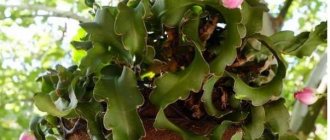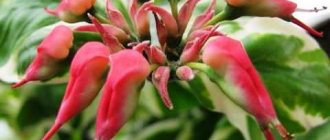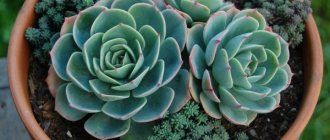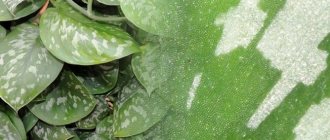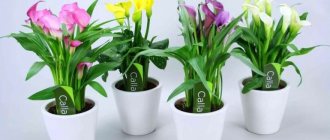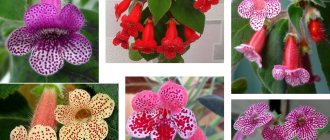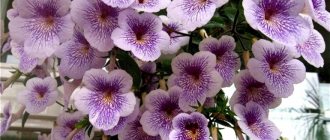Photo of a blooming Epiphyllum (Epiphyllum) is a beautifully flowering succulent from the Cactus family. In indoor culture it is grown as an hanging plant. Characterized by long, branched stems with flat or triangular edges. The flowers are large, funnel-shaped. It is also called phyllocactus.
At the base they are covered with small scales and spines. In nature it develops as an epiphyte; in indoor conditions it grows well on a substrate. Epiphyllum is native to tropical and subtropical regions of South America.
Also be sure to see how to grow prickly pear indoors.
| Average growth rate. |
| Blooms in spring and summer. |
| The plant is easy to grow indoors. |
| Perennial. |
Beneficial features
Epiphyllum oxypetalum.
Photo The fleshy fruits of phyllocactus can be eaten. Their healing properties were already known to the indigenous Indians. In folk medicine, the juice and leaves of the Dreamland epiphyllum variety are used to treat psoriasis and as an intestinal cleanser.
How to prune an epiphyllum flower
Epiphyllum: flower photo
This is also a very important process, which is directly related to flowering. In order to explain how, why and when it is carried out, we should also explain to you the structure of the epiphyllum.
The fact is that only one flower can appear on one areola of this plant, which means that after flowering they become virtually useless branches, and the only thing they do is take away precious resources from the shoots with flowers.
Therefore, it is quite obvious that those shoots that have already faded should be removed. This is done using a very sharp knife, which in your hands will not cause unnecessary harm to the plant. After cutting the branches, the cut area must be treated with charcoal to prevent possible infection.
Also, so-called triangular shoots sometimes appear on the home flower epiphyllum. You should also get rid of them, since they do not form flowers at all.
Features of growing at home. Briefly
Epiphyllum is grown quite simply at home:
| Temperature | Room temperature in summer, +13-15° in winter. |
| Air humidity | Needs periodic spraying. |
| Lighting | Bright, diffused, without direct sunlight. |
| Watering | Abundant in summer, 1-2 times a month in winter. |
| Priming | Light, fertile with mandatory drainage. |
| Feeding and fertilizer | During the period of intensive growth, once every 2 weeks. |
| Transfer | As it grows in the spring. |
| Reproduction | Cuttings and sowing seeds. |
| Features of cultivation | During the flowering period, the plant should not be rotated. |
Light level
Due to its characteristics, epiphyllum easily grows both in intense light and in a shaded place, but it blooms better when exposed to a large amount of scattered sunlight.
Direct light burns the plant stem, and this can cause the epiphyllum to wither or even die. If the flower does not have enough light, it turns yellow and does not throw out buds.
In the spring and summer, many experienced gardeners recommend taking epiphyllum outside or onto the balcony, where there is more fresh air.
Some even plant the plant in open ground at this time or bury it along with the pot, and in the photo of the epiphyllum it looks very original.
Epiphyllum: care at home. Details
Caring for epiphyllum at home should be carried out in compliance with certain rules.
Bloom
The flowering period of leaf cactus occurs at the end of spring - beginning of summer. Mature, well-developed plants are abundantly covered with large, fragrant flowers of white, red or pink. Each flower lasts about 5 days.
How to stimulate flowering
To stimulate the flowering of epiphyllum, all old shoots are cut out on the plant in the fall. If it was kept at high temperatures in winter, another pruning is carried out in the spring.
During pruning, all thin and elongated shoots are removed.
Temperature
Epiphyllum is grown at a temperature of +23-25°. With the beginning of autumn, the temperature must be reduced to +15°. It winters well even at +5°, so if you have an insulated loggia or veranda, you can take it there.
Spraying
Homemade epiphyllum adapts perfectly to the ambient air humidity. But if the temperature in the room rises above +26°, the plant must be sprayed daily. Spraying is also necessary during the period of intensive growth of leaf mass and during flowering.
Lighting
Bright but diffuse lighting is necessary. Windows facing east or west are best suited for growing it. You can grow a succulent from the north side, but in this case the flowering will be weak.
In order for the bush to develop evenly, the pot with the plant must be turned periodically. However, this should not be done once buds begin to form and during flowering. All the flowers may simply fall off.
Watering
In summer, water regularly and abundantly. But at the same time, the soil surface should dry out a little between waterings. In winter, the plant is watered very rarely. Usually 1-2 times a month is enough. When the temperature drops to +5°, watering is stopped completely.
Pot
The epiphyllum plant is grown indoors in spacious plastic or ceramic containers. The main thing is that drainage holes are made in their bottom. Despite the fact that it loves moisture, stagnation of moisture is destructive for it.
Priming
To grow epiphyllum, light, fertile soil is used. To compose the soil mixture, humus, turf soil and sand are used, they are taken in equal proportions. An industrial substrate for cacti is also suitable for growing. Before use, it is mixed with peat in a 1:1 ratio.
Feeding and fertilizer
During the period of intensive growth and during flowering, feed every 2 weeks.
For fertilizing, choose fertilizers with a high content of phosphorus and potassium; nitrogen is harmful to it.
Transfer
Epiphyllum is transplanted after the end of the flowering period. The plant is first allowed to rest for a month and only then replanting begins. Young, intensively growing specimens are replanted annually. Older plants as they grow, every 2-3 years.
Trimming
Epiphyllum needs constant pruning. It is carried out in the fall, before the start of the dormant period. All woody, crooked and damaged shoots are removed from the plant. Moderation should be observed when pruning. Buds are formed only on last year's shoots.
Rest period
For abundant flowering, epiphyllum requires a period of rest. Plants kept warm also bloom, but not as long and profusely. The dormant period lasts from late October to February.
During this period they are kept at +10-12°.
Selecting dishes and soil for planting
For proper growing season and beautiful flowering, the pot in which the cactus is grown is of great importance. When choosing a container, take into account the size of the plant and its tendency to grow upward. Adult flowers are transplanted at the age of 3-4 years only after the roots grow from below in the pot through the drainage holes. For young specimens, the soil is changed annually.
Pot size
The cactus does not have a very large rhizome, so it prefers shallow containers. In order for epiphyllium to bloom actively, the pot must be too small for its rhizome. This stimulates the flower to form buds. When replanting overgrown specimens, take flowerpots that are 2-4 cm larger than the previous ones.
If the rhizome of the plant is well developed, then it is better to choose deep containers for planting.
Utensil shape
Many gardeners try to grow cacti in rectangular containers so that as many pots as possible can fit on the windowsill. But this approach is wrong, since the close arrangement of plants prevents free air circulation. This can lead to root rot due to moisture disturbance. Therefore, for epiphyllum it is better to take a round pot.
Substrate for epiphyllum plants
To grow cactus, it is best to buy ready-made soil. You can also prepare the substrate yourself. To do this, you will need 4 volumes of turf and leaf soil, as well as 1 volume of peat, river sand and charcoal. These five components will need to be mixed thoroughly. If everything is done correctly, the soil will be loose and breathable.
Growing epiphyllum from seeds
Like the vast majority of other succulents, it is easy to grow from seed. They are sown in the soil mixture without subsequent incorporation. To maintain high humidity, planting containers are covered with film and kept at a temperature of +25°. Crops must be ventilated periodically, removing accumulated condensate.
Shoots appear in 2-3 weeks. After this, the film is immediately removed. First, the seedlings acquire a faceted shape, which is not typical for epiphyllum; they will become flat after 3-4 months of cultivation. Plants grown from seeds bloom after 4-5 years.
How to replant epiphyllum
Epiphyllum plant: flower photo
This procedure is not regular for the epiphyllum plant, and it is carried out only if necessary. For example, if a pot is cracked or if you want to propagate a cactus, but we will talk about this later. Also, the reason for transplanting epiphyllum may be the desire to make the plant part of a flower arrangement.
As for the tightness, there is absolutely no need to worry about this. The epiphyllum does not suffer from this at all, and even if you see a root sticking out from the ground, this is not a reason to sound the alarm and carry out an urgent epiphyllum transplant.
However, there are certain periods when transplanting epiphyllum is strictly prohibited: these are periods of bud maturation and flowering itself. The fact is that by replanting a plant that is at one of these stages of the growing season, you will most likely disrupt internal processes and deprive yourself of flowers this year.
As for choosing a new pot, it should be only slightly larger than the previous one. The fact is that the plant should not feel too free, since in this case too much of its resources will be spent on the formation of new shoots and roots, and on the contrary, not enough on growing beautiful buds.
By the way, it also follows from this that the pot should in no case be fragile and brittle, since its root system will constantly put pressure on its walls and the chance that the flower will damage its own home is very high.
Propagation of epiphyllum by cuttings
The tops of well-developed last year's shoots are suitable for propagation. Cuttings 10-15 cm long are cut from them. Their base must be given a wedge-shaped shape. After this, the cuttings are dried for 2-3 days until a characteristic glassy crust forms on the cut. For planting, use clean sand or soil for succulents.
Cuttings are planted vertically to a depth of 1 cm. Plants grown from cuttings bloom the next year.
Cuttings can also be rooted above water. To do this, after drying, they are fixed in a container so that their lower part is as close as possible to the surface of the water. After the formation of root primordia, the cuttings are immediately planted in the substrate.
Botanical description of the plant
Epiphyllum is a phyllocactus that is widespread in Mexico and along the coast of America. Since it belongs to the Cactus family, its surface is covered with spines. They grow as shrubs, and their base is woody (while the stem is leaf-shaped and fleshy). The cactus has oval-shaped flowers with a long flower tube. Their flowering period is April–June.
The flower can be of almost any color (for example, yellow, red, white, pink and others - except blue). Its size is quite impressive, and the buds consist of pointed petals arranged in tiers. One corolla can reach a length of 40 cm, and its diameter reaches 8–16 cm. Usually the flowers begin to emit a pleasant smell and bloom at night, but some of them do this during the day.
Important! Do not rush to take the fruit with your hands, as it is covered with yellow-green or red spines. It is completely edible, and its pulp has a strawberry-pineapple sweet taste.
This plant is capable of bearing fruit, but for this it is necessary to ensure cross-pollination. They are quite large in size and visually resemble a plum. Their pink thin skin hides juicy pulp and several black seeds up to 2 mm long.
The main characteristics of the epiphyllum are collected in the table:
| Root system | Underdeveloped |
| Stem | Long, fleshy |
| Leaf Shape | Oval |
| Leaf color | Dark green |
| Flower shape | Round |
| Flower color | White, yellow, red, pink, etc. |
| Fruit shape | Oval |
| Fruit color | Pink |
| Taste of fruits | Strawberry-pineapple |
Diseases and pests
Flower growers very often face a number of problems:
- Epiphyllum does not bloom. The flowering period may be absent due to non-compliance with wintering conditions, lack of lighting, or excess nitrogen in the soil. It is necessary to adjust the conditions of maintenance, providing the plant with proper wintering with a sufficient level of illumination.
- The buds have fallen. The problem occurs when turning or moving the plant.
- Black spots on the leaves appear as a result of the development of black rot. The affected plant must be treated with a fungicide, for example, Fundazol.
- Light brown spots on the leaves indicate the development of a fungal infection. Fungicides are also used for treatment.
- Yellow-red spots on the leaves are the result of water entering the sun when watering.
- The roots rot. The problem occurs when there is excessive watering and lack of drainage. To save the plant, an emergency transplant is carried out with the removal of rotten roots.
- Shoots wrinkle and lose turgor with a lack of moisture and exposure to the sun. The plant must be provided with sufficient watering by moving the pot to a place with diffused lighting.
- Epiphyllum leaves are cracking . When using fertilizing with nitrogen, leaf blades may crack. Fertilizer application must be temporarily stopped.
The most common pests are mealybugs, spider mites, and thrips. To combat them, special insecticides are used.
Transfer
Replant as necessary - adult plants, young plants - annually. Replant after flowering or in spring from late February to May at any time. Do not replant if buds appear on the shoots! Do not replant purchased flowering plants.
Which pot to choose
Young epiphyllums have erect stems, and for the first year or two they grow as a bush; they can be planted in a regular pot. Over time, the shoots lengthen and droop. You can transplant the plant into a hanging pot, or leave it in a regular pot of a suitable size, but install a support in it. In any case, the planting container is spacious and shallow, taking into account the lower drainage. Epiphyllum does not tolerate pots that are too spacious - if there is a lot of soil left undeveloped by the roots, it is easy to flood and destroy the plant.
The soil
Soil for epiphyllum: light, rich in humus, well drained, pH 5.8-6.5. You can use the following components:
- 3 parts coconut fiber (or substrate)
- 1 part agroperlite
- 1 part universal soil (garden soil or from a pack - Terra Vita Living Earth)
- 0.1 part bone meal (in the fertilizer department)
Another soil recipe suitable for forest epiphytic cacti:
- 2 parts leaf soil
- 1 part coconut substrate
- 1/3 part of well-rotted compost (manure that has been sitting for 2-3 years)
- 1 part vermiculite
- 1 part fine gravel chips (3-5 mm)
After preparing the earthen mixture, enlarge the holes at the bottom of the pot for water drainage, add drainage made of polystyrene foam or large expanded clay, now you can plant.
Types of home epiphyllum with photos and names
The following types are most often used in indoor floriculture:
Epiphyllum anguliger or angular Epiphyllum anguliger
A highly branched species with rounded or triangular stems that become woody at the base. The length of the stems can reach 1 meter or more. The flowers are medium-sized and bright red.
Epiphyllum oxypetalum
The species is characterized by large plants up to 3 meters high. The stems are flat with wavy edges. The flowers are very large, their average diameter is 15 cm or more.
Epiphyllum hookeri
Characterized by long, cascading stems and white flowers. It grows naturally in Cuba.
Epiphyllum crenatum
The stems are bluish-green in color, up to 80 cm long, with carved edges. The diameter of the flowers is about 15 cm. Their color varies depending on the variety.
Epiphyllum phyllanthus Epiphyllum phyllanthus
It grows naturally in South America. The length of the shoots reaches 1 meter. The flowers are pink, very large.
Guatemalan epiphyllum Epiphyllum guatemalense
The stems consist of parts shaped like oak leaves. The size of each individual link is about 5 cm. The flowers can be pink, red or white.
Epiphyllum ackermanii
The stems are flat, drooping with jagged shoots at the base. The flowers are bright red and sit on a characteristic thin stalk.
Epiphyllum Laui Epiphyllum laui
A species with large stems covered with very thin needles up to 4 mm long. The flowers are milky or creamy and open only in the evening. They stay on the plant for about 2 days.
From wild to houseplant
Epiphyllum belongs to the cactus family; in the wild they live on tree trunks and branches. However, unlike parasitic species, they independently obtain food from the air and sediment. In this case, the “donor” plant does not suffer at all. The name epiphyllum is borrowed from the Greek language, roughly translated it means “flower on leaves.” This fully reflects the appearance of a forest cactus. Wild varieties are found primarily in South and Central America, where the climate is tropical or subtropical.
Today, epiphyllums have been domesticated through hybridization with related species. Thanks to this, they settled in many houses and apartments. They are used to decorate gazebos, garden paths, terraces, planted in large pots. They feel great in the fresh air, but in the warm season. In apartments, placement is allowed on balconies and loggias. They look great in hanging pots as the long leaves and flowers hang over the edges.
Varieties for home cultivation
Epiphyllums are different, but they have a lot in common. For example, flowers can only be pure white or tinged with red. They grow on leaf-like appendages with serrations. There are more than 22 varieties in total, and only a few of them are suitable for home use.
With red flowers:
- Phyllanthes is distinguished by its large flowers; when they bloom, they reach 18 cm in diameter. The plant itself is small, jagged without a strong depression.
- Serrated - the flowers are also huge (up to 12 cm in diameter), with many deep red petals. It grows quickly, producing a large number of shoots.
- King Midas is a medium-sized bush with packed peach-colored flowers. Needs good lighting and watering.
- Sabra are bright pink flowers that bloom at night. They are arranged in a cluster, often opening several at once on one shoot.
With white and cream:
- Lau - its thin stems still have needles. The flowers are white with a creamy tint and wide triangular-shaped petals, blooming in the evening.
- Jennifer Ann is an original species with large flowers. The central part is painted white, and the side petals are rich yellow-green.
- Angular is the largest and most unusual in this category. Its flowers are white and large (up to 16 cm in diameter), and the shoots resemble fern leaves with thickening.
Epiphyllum varieties can be easily distinguished by the shape of the shoots, sizes and types of flowers:
Two large-sized flowers of the epiphyllum King Midas
The peach or salmon hue of the epiphyllum King Midas petals reminds of the sunset
Huge Epiphyllum Jennifer Ann flowers are white and yellow-green.
The young epiphyllum angularis will soon grow to gigantic proportions
Blooming epiphyllum completely covers the pot
Combination of different shades on the petals of Epiphyllum Sabra
Epiphyllum angularum flowers will decorate your home greenhouse
Pink epiphyllum phyllanthes is not afraid of proximity to other flowering plants
Bright red petals of Epiphyllum Ackerman of a rich hue
Double flowers of Epiphyllum Sabra grow very large
Modest and delicate flowers of epiphyllum angularis

